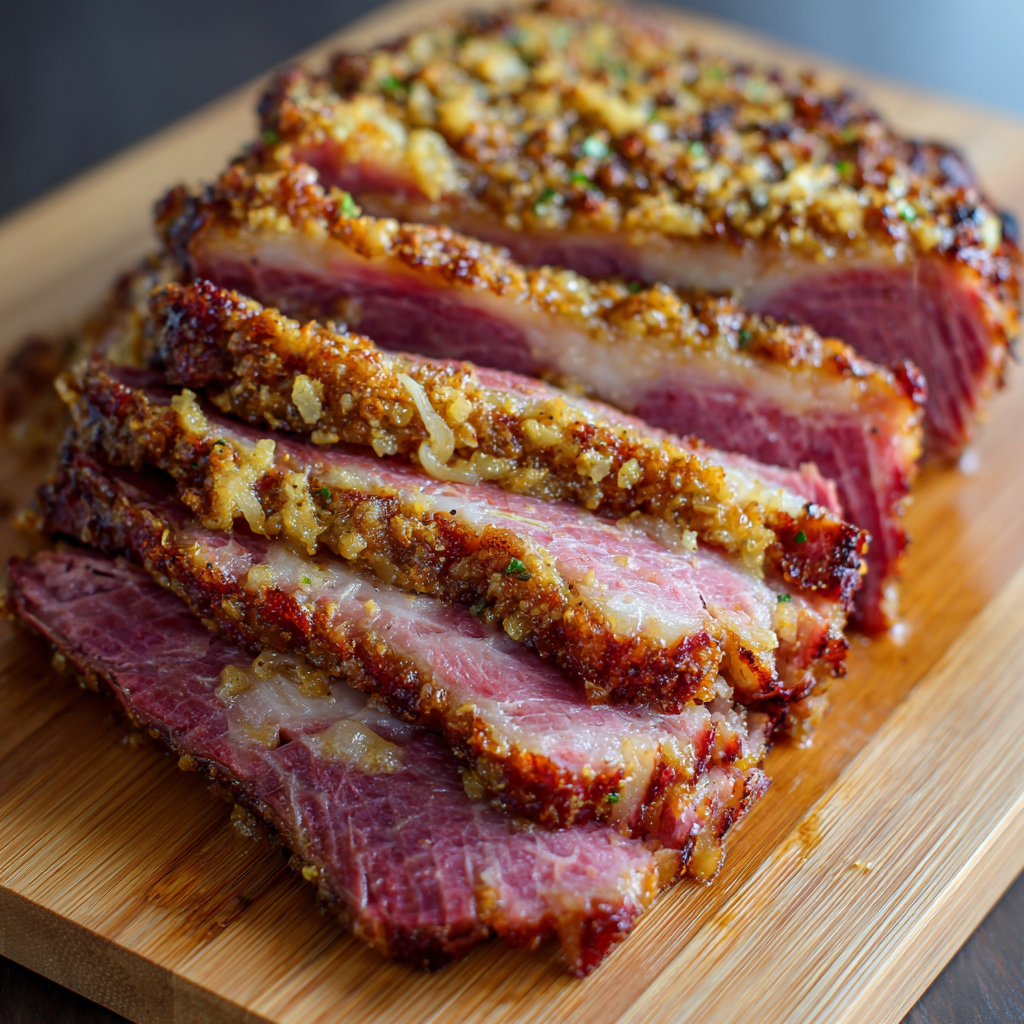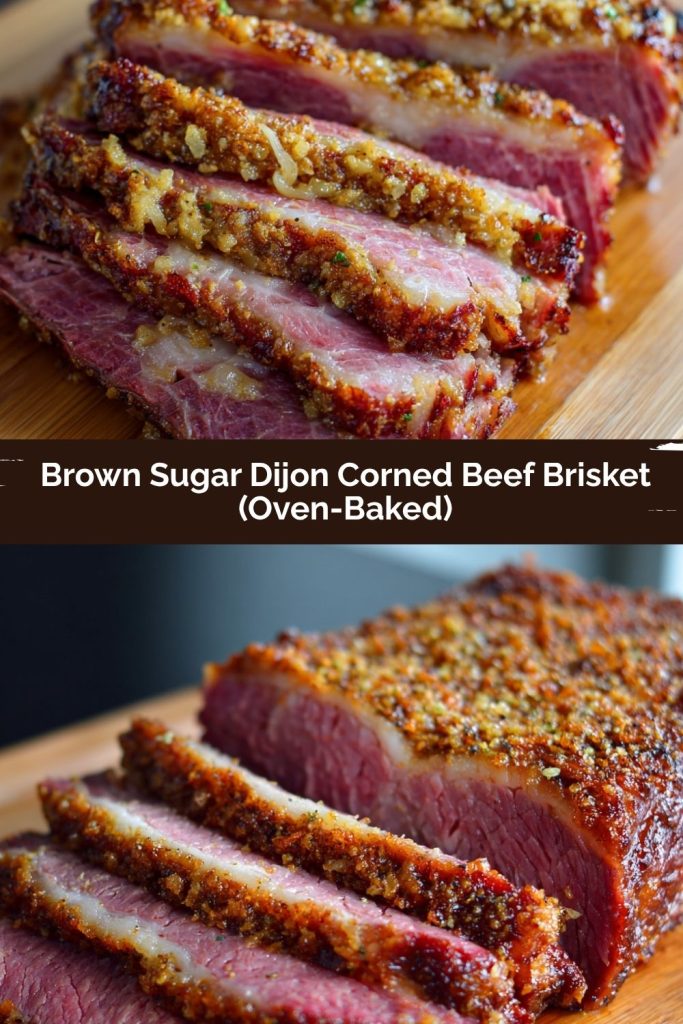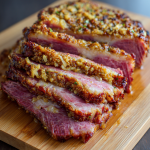Brown Sugar Dijon Corned Beef Brisket: Your New Favorite Oven-Baked Wonder
Hey there, friend! Can you smell that? That incredible, savory, slightly sweet aroma that seems to hug every corner of the house? That’s the smell of a meal made with love, and today, we’re creating exactly that. If you’ve ever looked at a corned beef brisket and felt a little intimidated, or if you’ve only ever boiled it and wondered if there was a way to make it truly spectacular, you’ve come to the right place.
I’m pulling back the curtain on what might just become your new go-to recipe for a stunning, no-fuss dinner. We’re talking about an Oven-Baked Brown Sugar Dijon Corned Beef Brisket. This method is my absolute favorite because it’s hands-off, incredibly forgiving, and transforms a simple brisket into a tender, flavor-packed masterpiece with a gorgeous, caramelized crust. It’s the kind of dish that looks like you fussed for hours, but secretly, you know the oven did all the heavy lifting.
So, whether you’re prepping for a cozy Sunday supper, a festive St. Patrick’s Day feast, or just craving some serious comfort food, this recipe is your ticket. It’s all about simple ingredients doing extraordinary things. Let’s turn that ordinary brisket into an extraordinary memory, shall we?
A Little Story & a Lot of Nostalgia
PrintBrown Sugar Dijon Corned Beef Brisket (Oven-Baked)
- Prep Time: 10 minutes
- Cook Time: 2 hours 30 minutes
- Total Time: 2 hours 40 minutes
- Yield: 4–6 1x
Ingredients
1 corned beef brisket (about 2 lbs)
¼ cup brown sugar (adjust to taste)
2 tablespoons Dijon mustard (optional, adds great tang)
Aluminum foil
Instructions
Preheat oven to 350°F (175°C).
Trim brisket of excess fat if desired.
Rub the brisket all over with Dijon mustard (if using), then coat generously with brown sugar.
Wrap tightly in aluminum foil to seal in juices.
Bake in a baking dish or sheet for 2 hours and 30 minutes.
Let rest for 10 minutes before slicing.
Tips:
For extra caramelization, unwrap during the last 10–15 minutes of baking.
Delicious served with roasted veggies, cabbage, or on rye bread for sandwiches.
This recipe always takes me right back to my grandma’s kitchen. She wasn’t Irish in the slightest, but she believed corned beef was a monthly essential, a cure for everything from a long week to a case of the blues. Her version was classic—simmered for hours with cabbage and potatoes. It was wonderful, but it was always…well, beige.
One year, I decided to put my own spin on her tradition. I was in a “more-is-more” phase (some might say I still am!), and I thought, “What if we gave it a little glow-up?” I remember the look on her face when I pulled this glistening, mahogany-hued brisket out of the oven. The brown sugar had caramelized into a sticky, savory-sweet crust, and the mustard added a subtle, sophisticated tang. She took one bite, her eyes widened, and she said, “Well, Anna, you’ve outdone yourself. This is the one.” From that day on, our family corned beef was forever changed. It’s a reminder that the best recipes aren’t just about following rules; they’re about creating new stories and flavors that become your own.
Gathering Your Kitchen Magic
Here’s the beautiful part: you only need a few key players to create this magic. The simplicity is what makes it so brilliant. Let’s break down our star ingredients:
- 1 Corned Beef Brisket (about 2 lbs): This is our main event! When you buy it from the store, it almost always comes pre-brined and nestled in a spiced packet. That’s your secret weapon for built-in flavor. Don’t rinse it—those spices are gold! A 2-pound brisket is perfect for 4-6 people, but the recipe scales up beautifully if you’re feeding a crowd.
- ¼ Cup Brown Sugar: This isn’t just for sweetness. The molasses in the brown sugar is what creates that incredible, glossy, caramelized crust we’re dreaming of. It balances the saltiness of the beef perfectly. Feel free to adjust to your taste—a little more for a sweeter glaze, a little less for a more savory profile.
- 2 Tablespoons Dijon Mustard (Optional, but oh-so-recommended!): Don’t let the “optional” fool you. The Dijon is my chef’s secret. It adds a sophisticated, tangy depth that cuts through the richness and keeps the dish from being one-note. It’s the “what is that amazing flavor?” factor. If you’re not a mustard fan, you can skip it, but I promise it mellows and melds beautifully.
- Aluminum Foil: Our trusty kitchen sidekick! This creates a steamy, cozy environment in the oven, essentially braising the brisket in its own juices. The result? Meat so tender you won’t believe it.
Let’s Cook! Your Step-by-Step Guide to Brisket Bliss
Ready to make some magic? I’ll walk you through every single step. Put on your favorite apron, and let’s do this!
Step 1: Preheat and Prep. First things first, get that oven preheating to a cozy 350°F (175°C). This is the perfect temperature for low-and-slow cooking that will gently break down all the tough connective tissue in the brisket, leaving you with melt-in-your-mouth tenderness. While it’s warming up, take your brisket out of its package. You’ll notice it’s a bit fatty on one side—that’s normal! If there are any truly excessive, thick pieces of fat, you can trim them, but I usually leave most of it. That fat will render and baste the meat, keeping it incredibly moist.
Step 2: The Flavor Rub. This is the fun part! Place your brisket on a large piece of aluminum foil (enough to wrap it up like a present). If you’re using the Dijon, grab a pastry brush or just use your hands (the best tools!) and rub that mustard all over every surface of the brisket. This acts as a “flavor glue” for our next step. Now, take your brown sugar and press it generously onto the meat, creating a beautiful, even coating. Don’t be shy! You want a nice, substantial layer that will transform into our glorious glaze.
Step 3: The Cozy Blanket. Carefully bring the edges of the aluminum foil up and over the brisket. We’re going to create a tight, sealed packet. Crimp the edges together really well—you want to trap every bit of steam and juice inside. This is the key to preventing a dry brisket! I like to place this foil packet right inside a baking dish, just in case any juices decide to make a break for it. No messy oven cleanup for us!
Step 4: The Patient Wait. Slide your beautifully wrapped brisket into the preheated oven and let it work its magic for 2 hours and 30 minutes. I know, it’s hard to wait with that amazing smell filling your kitchen! But trust the process. This long, slow cook time is non-negotiable for achieving that fall-apart texture.
Step 5: The Grand Finale (Optional, but Recommended!). After 2 hours and 30 minutes, your brisket is technically cooked and will be delicious. But if you want to take it to the next level, here’s my favorite chef hack: carefully open the foil packet (watch out for the hot steam!). Crank your oven up to broil for a minute or two, or just let it continue baking uncovered for the last 10-15 minutes. This gives the sugar crust a chance to bubble, caramelize, and become a deep, shiny, crackly glaze. It’s a game-changer!
Step 6: The Crucial Rest. I know you’ll be desperate to slice into it, but this might be the most important step! Take the brisket out of the oven, transfer it to a cutting board (keep it in the foil or pour those amazing juices into a gravy boat), and let it rest for a full 10 minutes. This allows the muscle fibers to relax and reabsorb all those incredible juices. If you slice it too soon, all the moisture will run out onto the board. A little patience here rewards you with the most succulent slices imaginable.
How to Serve Your Masterpiece
Now for the best part—digging in! How you serve this beauty is half the fun. For a classic, hearty meal, slice it against the grain (this makes it extra tender!) and serve it alongside buttery roasted carrots and potatoes, or with simple steamed cabbage. Those pan juices? That’s liquid gold! Drizzle them right over the top of the sliced meat for an extra burst of flavor. Leftovers (if you’re lucky enough to have any!) are a dream. Pile thin slices onto toasted rye bread with a swipe of mustard and some sauerkraut for what might be the best Reuben sandwich of your life.
Make It Your Own: Delicious Twists & Swaps
This recipe is a wonderful canvas for your creativity! Here are a few of my favorite ways to mix it up:
- Spicy Kick: Add 1 tablespoon of horseradish to the Dijon and brown sugar rub. It adds a fantastic, sinus-clearing zing!
- Orange Zest Glow-Up: Add the zest of one whole orange to the rub. The citrus brightens everything up and pairs wonderfully with the brown sugar.
- Whiskey Glaze: Whisk 1 tablespoon of whiskey or bourbon into the mustard and brown sugar mixture for a deep, smoky undertone.
- Honey Mustard Version: Swap the brown sugar for an equal amount of honey for a different kind of sweet, floral glaze.
- Low-Sugar Option: You can reduce the brown sugar to 2 tablespoons, or use a sugar-free brown sugar substitute for a less sweet, but still beautifully glazed, result.
Anna’s Chef Notes & Kitchen Stories
This recipe has been a part of my life for so long, it’s practically family. Over the years, I’ve learned a few things. First, not all briskets are created equal. Some are fattier, some are leaner, and cooking times can vary slightly. If you have a larger brisket (say, 3-4 lbs), just add another 30-45 minutes to the cooking time. The foil packet method is very forgiving.
I also have a funny story about the first time I made this for a dinner party. I was so proud of my caramelized crust that I decided to broil it for “just one more minute.” I got distracted chatting with a friend, and when I turned around, the smoke alarm was serenading my guests! The sugar had gone from perfectly caramelized to slightly… charred. But you know what? We sliced off the very top layer, and the meat underneath was still perfectly tender and juicy. My friends still talk about “that amazing corned beef,” completely unaware of its dramatic journey. The moral of the story? Don’t stress! This recipe is resilient and hard to mess up.
Your Questions, Answered!
I’ve gotten so many wonderful questions about this recipe over the years. Here are the most common ones to help you feel super confident:
Q: My brisket turned out a bit dry. What happened?
A: Oh no! The most common culprit is not wrapping the foil tightly enough, which lets the precious steam escape. Another possibility is slicing it immediately without letting it rest. Those juices need time to settle back into the meat! Finally, make sure you’re using the packet of spices that came with the brisket—it’s seasoned with salt and flavor that helps keep it moist.
Q: Can I make this in a slow cooker or Instant Pot?
A: Absolutely! For a slow cooker, follow the same rubbing steps, place the brisket in the pot, and cook on LOW for 8-9 hours. For the Instant Pot, add 1 cup of water or beef broth, place the trivet inside, and set your rubbed brisket on top. Cook on high pressure for about 90 minutes, with a natural pressure release.
Q: Do I need to add water to the baking dish?
A> Nope! The brisket will release plenty of its own liquid as it cooks, creating a steamy environment inside the foil packet. Adding water to the dish would just steam the outside of the packet and isn’t necessary.
Q: Can I prepare this ahead of time?
A: You can! You can rub the brisket with the mustard and brown sugar mixture, wrap it tightly in foil, and keep it in the refrigerator for up to 24 hours before baking. Just let it sit at room temperature for about 30 minutes before it goes in the oven to take the chill off.
Nutritional Information (Approximate)
Please note: This is an estimate per serving (based on 6 servings) and can vary greatly based on the specific brisket and ingredients used. The pre-brined corned beef is inherently high in sodium.
Calories: ~450 | Protein: 30g | Fat: 25g | Saturated Fat: 8g | Carbohydrates: 12g | Sugar: 11g | Sodium: ~1500mg

Final Thoughts
There’s something truly special about a recipe that feels effortless yet delivers the kind of comfort that lingers long after dinner. This Brown Sugar Dijon Corned Beef Brisket is exactly that — simple ingredients, slow-baked magic, and a payoff that tastes like you spent all day in the kitchen. The tender slices, the caramelized glaze, the balance of sweet and savory… it’s everything a cozy meal should be.
Whether it’s St. Patrick’s Day, a Sunday supper with family, or just a night when you’re craving something that feels like home, this recipe never disappoints. It’s a reminder that comfort food doesn’t have to be complicated — just made with care, patience, and a little bit of brown sugar love. Serve it proudly, share it generously, and don’t be surprised when everyone asks for seconds (and the recipe!).
